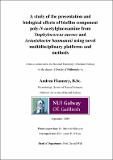| dc.description.abstract | Biofilm formation on medical devices is major cause of concern in today’s society as implanted devices are associated with 60-70% of nosocomial infections. Poly-N-acetylglucosamine (PNAG) is a polysaccharide found on many Gram-positive and Gram-negative pathogenic bacteria and is associated with biofilm formation and bacterial virulence. PNAG production is regulated via the icaADBC (ica) operon in Staphylococcus aureus and the pgaABCD (pga) operon in Acinetobacter baumannii. We urgently need to understand how this polysaccharide interacts with the host’s immune system. Methods of rapidly identifying novel PNAG host receptor targets are urgently needed to help to develop anti-bacterial and anti-biofilm compounds to prevent biofilm-associated infections.
We first employed lectin and neoglycoconjugate (NGC) microarrays to screen for lectin and carbohydrate interactions with wild type (PNAG-producing) and non-producing (ica or pga mutant, respectively) S. aureus and A. baumannii grown under various conditions. Depending on the environmental growth conditions, wild type S. aureus 8325-4 and Mn8m had increased binding to GlcNAc-specific lectins compared to their respective mutants, methicillin resistant S. aureus (MRSA) strain BH1CC wild type had increased binding to GlcNAc- and GalNAc- specific lectins and A. baumannii wild type had increased binding to Gal and GalNAc-specific lectins. However, as expected, PNAG isolated from S. aureus bound to only the GlcNAc-specific lectins, wheat germ agglutinin (WGA) and succinylated wheat germ agglutinin (sWGA). S. aureus wild type had increased binding to a range of carbohydrates including 3’- and 6’-sialyllactose and several Lewis structures including Lewis b and x. S. aureus BH1CC bound to the same and different structures compared to methicillin sensitive S. aureus (MSSA) strains, 8325-4 and Mn8m, but at much lower intensity and there was a general decrease in BH1CC ∆ica binding to NGCs compared to the wildtype, but no differences in binding patterns were observed. For A. baumannii, the mutant exhibited significantly reduced binding to GlcNAc-BSA, blood group A-BSA and ovomucoid. Overall, these results indicated that PNAG was recognised differently when on the surface of A. baumannii compared to S. aureus despite PNAG from either species being similarly recognised by itself. Furthermore, we provided a range of potential carbohydrate ligands for S. aureus, A. baumannii and PNAG, indicating the presence of specific bacterial lectins.
In chapter 3, lectin microarrays were used to identify plant lectins that specifically recognised PNAG and used multivalent GlcNAc derivatives or glycoclusters to modulate these lectin interactions in a targeted manner. A PNAG preparation from S. aureus was fluorescently labelled and used to mimic secreted PNAG that would be released from a cell in to the biofilm matrix and PNAG was covalently bound to a 1.0 μm fluorescent carboxylate-modified microsphere to mimic the morphology of PNAG on a bacterial cell surface. Six bivalent glycoclusters with GlcNAc as the bioactive head group were used to target WGA binding to the GlcNAc-containing glycoprotein, ovalbumin, neoglycoconjugate, GlcNAc-BSA, PNAG and whole S. aureus bacteria. Glycocluster sos2211 had the lowest IC50 value for inhibiting WGA binding to ovalbumin of 0.6554 µM and sos2210 produced to lowest IC50 value for WGA binding inhibition to GlcNAc-BSA of 5.32 aM. Sos2211 at 1 mM significantly reduced WGA binding to PNAG (both directly labelled and covalently attached to a 1.0 μm carboxylate-modified microsphere) and S. aureus Mn8m. Glycoclusters were also used to inhibit biofilm formation and S. aureus attachment to mucin purified from a cystic fibrosis patient. Bivalent glycoclusters, sos2222 and sos2221 decreased S. aureus 8325-4 and Mn8m biofilm formation by 16% and 19%, respectively. The tri- and tetra- valent glycoclusters, sos2226 and sos2227, significantly reduced both MRSA and MSSA biofilm formation however both were found to precipitate by themselves in culture. Addition of 1 mM of sos2211 to PNAG decreased PNAG interactions with mucin purified from one cystic fibrosis patient, but increased S. aureus Mn8m interactions with the same mucin fraction. Overall, the work of chapter 3 demonstrated that the microarray platform is a suitable, sensitive and reproducible for calculating IC50 values and glycoclusters may be a promising avenue for targeted therapeutic development.
Finally, in chapter 4 pathogen recognition receptors (PRRs) were screened for interactions with S. aureus, A. baumannii and PNAG on a PRR microarray. DC-SIGN, DC-SIGNR, LSECtin, MMR, ficolin-3 and CD14 bound to S. aureus and A. baumannii. PNAG increased CD14 binding to MSSA strains, the presence of the ica operon increased DC-SIGN, LSECtin and ficolin-3 binding to MRSA strain BH1CC though only LSECtin binding differences were significant, while PNAG on A. baumannii resulted in increased adherence to siglec-1, DC-SIGN, dectin-1 and -2, LSECtin, TLR2/4, TLR2/6 and TLR2/CD14. Using a THP1-Blue-CD14 cell assay, PNAG purified from S. aureus or A. baumannii did not activate NF-κB/AP-1 signalling via TLRs or CD14. Instead, PNAG on the surface of S. aureus promoted activation of NF-κB/AP-1 signalling and increased concentrations of cytokines and chemokines including IL-8, RANTES and IL-1β. There was no difference in NF-κB/AP-1 signalling between wild type and A. baumannii ∆pga. A dot blot against lipoteichoic acid (LTA) for S. aureus wildtype and ∆ica mutant suggested that the ∆ica mutant had reduced expression of LTA. Furthermore, imaging flow cytometry demonstrated that PNAG from S. aureus and A. baumannii was internalised by monocytes. This chapter highlighted the different roles for PNAG on, and purified from, S. aureus and A. baumannii in PRR mediated interactions, monocyte penetration and innate immune system activation, and highlights the importance of the surface expression and presentation of pathogen associated molecular patterns (PAMPs) for eliciting signalling responses.
Overall, this work proves that the microarray platform was successful in screening for bacteria-receptor interactions and can also be used to screen for targeted modulatory compounds. This thesis also shows the different roles of PNAG in lectin-mediated interactions and innate immune system activation, and highlights the necessity of the surface expression and presentation of PAMPs for eliciting signalling responses. | en_IE |


